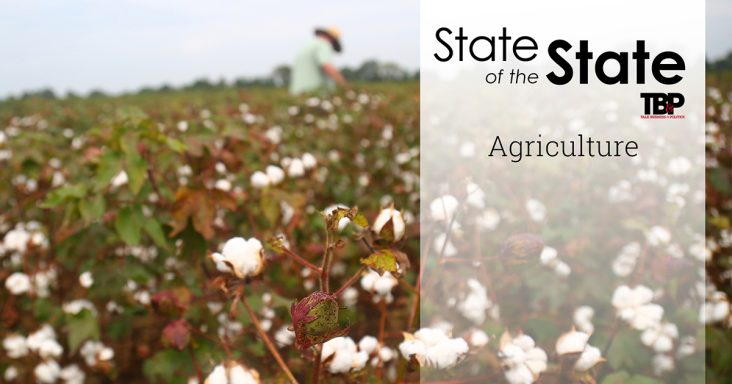State of the State 2024: Arkansas ag sector enters 2024 after healthy 2023
by January 29, 2024 6:27 pm 1,124 views

Editor’s note: The State of the State series provides reports twice a year on Arkansas’ key economic sectors. The series publishes stories to begin a year and stories in July/August to provide a broad mid-year update on the state’s economy. Link here for the State of the State page and previous stories.
Arkansas’ agriculture sector ballooned into a nearly $21 billion industry in 2023 despite drought, fluctuating commodity prices, input cost hikes and other factors. Nearly 42% of the state’s land is comprised of farms, according to Arkansas Agricultural Profile.
In terms of cash receipts, the largest agriculture sub-sectors include broiler (chicken) production with a value of $3.971 billion; soybeans with a value of $1.635 billion; and rice with a value of $1.332 billion. Other top agricultural commodities include turkeys, cotton, corn, and cattle.
Commodity prices were up and input costs such as fertilizer declined. This led to acreage expansion for several crops in the state including soybeans, corn, and peanuts.
Soybeans
At the start of the 2023 growing season, soybeans were projected at $13.65 a bushel. By harvest, however, the number fell to $12.84. Soybeans are the most widely grown crop in Arkansas and there were more than 3 million acres harvested this last year.
The Prospective Plantings report pegged U.S. soybeans at 87.5 million acres. The Acreage Report found 83.5 million acres. Yields in Arkansas are projected to set a state record. The projected yield of 53 bushels per acre is one bushel more than the previous record per acre set in 2021.
Corn
Corn made a strong return in the Arkansas Delta in 2023 in terms of bushels and acres harvested. Producers gathered 149 million bushels of corn from about 830,000 acres, an average yield of 180 bushels per acre, according to the U.S. Department of Agriculture (USDA).
Compared to 2022, it was about seven more bushels per acre on 135,000 more acres of corn planted. In 2022, farmers only harvested about 700,000 acres. The yield maintains the state’s 10-year average of 180 bushels per acre.
Rice
Arkansas is the top rice growing state, typically growing about half of the nation’s crop annually. An estimated 1.3 million acres were planted this season, and uptick of about 200,000 acres from 2022.
Jackson County is the top rice growing county in the state this last year with a little more than 112,000 acres dedicated to the crop, according to the Farm Service Agency. Poinsett County ranks second with 107,000 acres while Lawrence County is third with 104,000 acres.
The state set its all-time yield record in 2021 with 170 bushels per acre. The 2023 crop could approach that yield record once all the rice harvested has been milled.
Peanuts
Last year, Arkansas growers produced 166.4 million pounds of peanuts on 32,000 acres. The value of Arkansas’ peanut crop is more than $42 million. Runner peanuts – the type used in peanut butter – account for almost 100% of the state’s peanut crop. These varieties consistently have high yields and remain in high demand.
Peanut acreage in Arkansas has fluctuated over the past decade, dipping from about 18,000 acres in 2012 to about 10,000 acres in 2014, then steadily climbing since. In Arkansas, the leading peanut counties include Mississippi and Craighead counties, with smaller acreages in Greene, Lee, St. Francis and other counties in the Delta region.
The crop could surpass its all-time yield record of 5,288 pounds per acre set in 2017.
Cattle
Cattle prices improved in 2023. Throughout most of the year, both futures and cash markets for steers, calves improvement steadily when compared to the previous year. By the last week of November, prices for medium and large number one steer calves (weighing 500 to 600 pounds) were above $270 per hundredweight, more than $80 per hundredweight higher than the same time in 2022 and more than $100 higher than the average from 2017-2021.
Arkansas ranks 11th in the country in terms of cattle production, according to the Arkansas Farm Bureau. The state has 23,385 cattle farms and that’s 54% of all farms in the state. Cash receipts for cattle producers average about $600 million per year.
Cotton
Cotton acreage dropped across the country and in Arkansas. Nationally, cotton acreage fell 19% this year to an estimated 11.1 million acres. In Arkansas, acreage fell by 25% to 480,000 acres.
Poultry and eggs
Arkansas ranks third in the country in terms of broiler production. The state on average produces more than 7.46 billion pounds of broiler meat, annually.
Arkansas is third in national ranking of turkey production, according to the USDA’s Turkeys raised report. The Natural State has produced 27.5 million turkeys this year, a 6% increase when compared to last year. Overall, 219 million turkeys were raised in the U.S. this year, a 4% increase.
On average, more than 300 million eggs are produced in Arkansas per month. That average was up about 1% last year, according to the USDA. The number of hens laying eggs exceeded more than 15.6 million.
